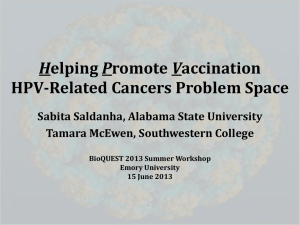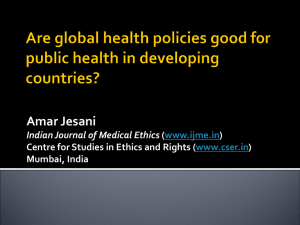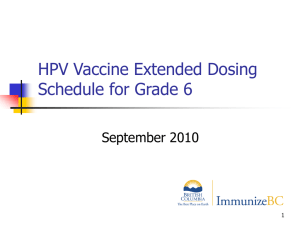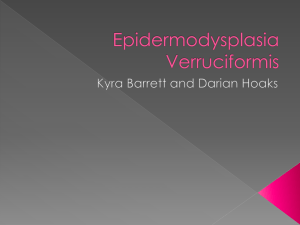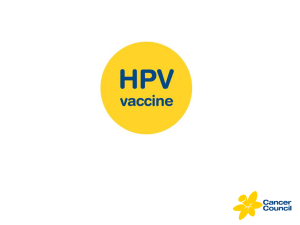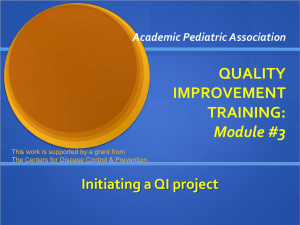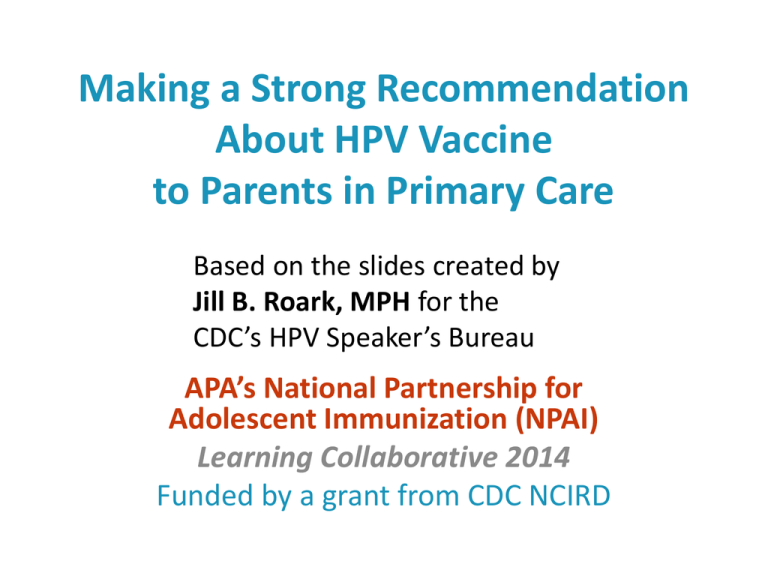
Making a Strong Recommendation
About HPV Vaccine
to Parents in Primary Care
Based on the slides created by
Jill B. Roark, MPH for the
CDC’s HPV Speaker’s Bureau
APA’s National Partnership for
Adolescent Immunization (NPAI)
Learning Collaborative 2014
Funded by a grant from CDC NCIRD
National Partnership for
Adolescent Immunization (NPAI)
PI: Peter Szilagyi
Coordinators: Christina Albertin, Nui Dhepyasuwan
FACULTY & CONSULTANTS
Donna D'Alessandro
Ed Marcuse
(communication expert)
William Atkinson
Cindy Rand
Paul Darden
Stanley Schaffer
Sharon Humiston
(moderator)
Janet Serwint
Keith Mann
William Stratbucker
Will Findlay, Instructional Design
Introduction
HPV vaccine is an important routinely recommended
vaccine that is underutilized.
If it were given with the other routine vaccines with the same strength of provider recommendation –
it is likely that more people would be protected.
This talk is designed to give you:
1. A practical immunization communication
strategy
2. Accurate and succinct answers to FAQs
about HPV vaccination
3. Tips on having your whole office team feel
comfortable communicating about HPV
vaccine
Recommend
Objective #1
A PRACTICAL IMMUNIZATION
COMMUNICATION STRATEGY
Recommend-Ask-Acknowledge-Advise
approach:
Is a framework for the immunization conversation
Was developed by Vax Northwest – a Seattlebased collaborative
Is stepwise, based on reactions specific to the
family
Has focused on and been tested in preschool (not
adolescent) immunizations. We recognize that
adolescent immunization is different (e.g., need
for assent).
Because we are emphasizing the 11-12 year old visit, we highlight
interactions with the parent, but the adolescent should be an
integral part of the conversation!
Recommend
Introduce the topic by clearly stating your
recommendations for the immunizations that are
due today.
Treat HPV just like the other routinely
recommended adolescent immunizations.
I think Quinn should get 3 shots today:
HPV vaccine, meningococcal vaccine and Tdap
vaccine.
I think Michelle should have 3 shots today
that will protect her from the cancers caused by HPV,
and infections causing meningitis, whooping cough,
tetanus, & diphtheria.
7
Ask (Use open-ended questions)
Ask what questions they have about the vaccines
or the schedule.
What questions do you have for me about these
vaccines?
Clarify and re-state their concerns to make sure
you understand.
It sounds like you’re concerned that the HPV vaccine
isn’t necessary because Emily is a virgin.
Am I understanding this?
8
Acknowledge –
Strategy for “Accepting Parent”
Support the parent’s decisions to follow the
recommended schedule.
I think staying up to date with the adolescent
vaccines is a great step to take.
Keeping Sophie up to date on vaccines is the single
most important way our office can work with your
family to keep her protected from serious diseases.
9
Acknowledge –
Strategy for “Hesitant Parent”
Acknowledge the parent's concerns
There are a lot of different opinion about vaccines
and a lot of conflicting information…
Make clear your goal is the same as the parents
I know you want to do everything you can to keep
Sophie safe, and so do I
Name the emotions you observe
Be clear that you are concerned for the health of
the adolescent, not just public health safety
10
Advise
• Address the parent's specific concerns
• Offer to assist them to get information
relevant to their concerns
• Allow them time to reflect, consult with their
spouse/partner
• Provide them with an opportunity to revisit
their concerns with you
• Develop a plan that is acceptable to the
parent, noting you understand that the
decision and burden of responsibility is theirs
• Schedule a follow-up appointment
11
1. Why is this vaccine needed?
2. Is HPV important?
• If a woman gets regular PAP smears she won’t
get cervical cancer.
• My son won’t get cervical cancer so why bother
with this?
3. Isn’t the HPV vaccine too new to know if it works?
4. Is HPV vaccine safe?
5. Why give this at 11 or 12 years of age?
6. Will my child see this as “permission” to have sex?
7. Would you give HPV vaccine to your child?
Objective #2
ACCURATE AND SUCCINCT ANSWERS
TO FAQS ABOUT HPV VACCINATION
For each question we will give you
a detailed answer with references
and some sample “scripts”
for use with parents.
FAQ 1: Why is this vaccine needed?
In focus groups, some moms:
Stated that they didn’t think HPV infection
was very common because
They had never heard that it was or
They didn’t know anyone who had an HPV
infection or HPV disease
Some moms couldn’t understand how their
child could become infected even if they
waited until marriage to have sex
U.S. HPV Prevalence & Incidence
US statistics
Currently infected
~79 million
New infections/year
~14 million
HPV infection is most common in people in their
teens and early 20s
HPV is the most common STI
…but most people never know that they have
been infected -- unless a woman has an
abnormal pap test with a positive HPV test
Jemal A et al. J Natl Cancer Inst 2013;105:175-201
HPV Transmission
HPV exposure can occur with any type of
intimate sexual contact.
Among a cohort of adolescent women without
prior vaginal intercourse (followed longitudinally):
HPV was detected in 46% of females prior
to 1st vaginal sex
70% of these women reported non-coital behaviors
that may in part explain genital transmission
Vaginal intercourse is not necessary
to become infected
Condoms do not completely stop HPV transmission
Jemal A et al. J Natl Cancer Inst 2013;105:175-201
Transmission During Intercourse
Nearly 50% of high school students have already
engaged in sexual (vaginal-penile) intercourse
1/3 of 9th graders and 2/3 of 12th graders have
engaged in sexual intercourse
24% of high school seniors have had sexual
intercourse with 4 or more partners
About 50% of people are infected with HPV
within 12 months of sexual debut
Jemal A et al. J Natl Cancer Inst 2013;105:175-201
Winer RL, Lee SK, Hugh JP, et al. Am J Epidemiolog 2003. 157:218-226.
Try saying:
The virus can spread without intercourse. Even virgins can
be infected with HPV.
HPV is so common that almost everyone will be infected at
some point. Yet most people never know that they have
had an HPV infection.
Even if your child waits until marriage to have sex, he/she
could still be exposed if his/her future partner engaged in
any type of sexual activity before marriage.
About 79 million Americans are infected with HPV and
there are 14 million new infections each year.
FAQ 2: Is HPV important?
In focus groups and online panels, mothers
wanted more information on the types of HPV
cancers
In focus groups mothers stated they were
influenced to vaccinate their child because
HPV vaccine prevents cancer
They had a family history of gynecological cancers
(cervical, ovarian), and/or
They had a personal experience with cervical cancer
FAQ 2 (female): Is HPV important?
If a woman gets regular PAP smears
she won’t get cervical cancer.
Cervical Cancer
Cervical cancer is the most common
HPV-associated cancer among women
In the U.S. (in the year 2011)
12,000+ new cases
4,000 attributable deaths
There are complications related to current
methods of cervical cancer prevention –
so it’s better to prevent the infection!
Infertility due to treatment of cervical cancer by hysterectomy
Cervical conization and loop electrosurgical excision procedure
(LEEP) are associated with adverse obstetric morbidity
Subsequent pregnancies are at risk of
Perinatal mortality
Preterm delivery – severe , extreme
Low birth weight – severe, extreme
These outcomes have a considerable impact
on the mothers and infants concerned
and on the cost of neonatal intensive care
FAQ 2 (male): Is HPV important?
My son won’t get cervical cancer
so why bother with this?
# of new HPV–associated cancers by sex, in U.S, 2009
Jemal A et al. J Natl Cancer Inst 2013;105:175-201
# of new HPV–associated cancers by sex, in U.S, 2009
Chaturvedi, 2011, J Clin Oncol- data from SEER
Jemal A et al. J Natl Cancer Inst 2013;105:175-201
# of new HPV–associated cancers by sex, in U.S, 2009
http://oralcancerfoundation.org/hpv/pdf/JNC-J-Natl-Cancer-Inst-2013-Jemal-175-201.pdf
Rates of HPV-associated cancers are
rising.
Oral cancer rates increased from 2000 to 2009
4.9%
3.9%
1%
for Native American men
for white men
for Asian men
If trends continue, the annual number of HPV-positive
oropharyngeal cancers is expected to surpass the annual
number of cervical cancers by the year 2020.
Anal cancer rates doubled from 1975 to 2009
Penile cancer rates increased among Asian men
Try saying:
HPV vaccine is very important because it
prevents cancer.
I want your child to be protected from cancer.
That’s why I’m recommending that your
daughter/son receive the first dose of the HPV
vaccine series today.
Or try saying:
HPV can cause many kinds of cancers – cancer of
the mouth, throat, and anus in both women and
men as well as the genitals [cervix, vagina, and
vulva in women, penis in men].
Each year, about 26,000 people in the U.S. face a
diagnosis of one of these cancers—and most could
be prevented with HPV vaccine.
There are also many more precancerous conditions
requiring treatment that can have lasting effects.
FAQ 3: Isn’t the HPV vaccine
too new to know if it works?
HPV Vaccine Impact
a. NHANES - HPV Prevalence Studies
National Health and Nutrition Examination Survey (NHANES)
Compares HPV prevalence
before the start of the HPV vaccination program with
first 4 years after vaccine introduction
Results:
In 14-19 yr olds, vaccine-type HPV prevalence decreased
56% (11.5% in 2003-2006 to 5.1% in 2007-2010)
Other age groups did not show a statistically significant
difference over time
Vaccine effectiveness for prevention of infection was an
estimated 82%
Cummings T, Zimet GD, Brown D, et al. Reduction of HPV infections through vaccination
among at-risk urban adolescents. Vaccine. 2012; 30:5496-5499.
HPV Vaccine Impact
b. Clinic-based Study
Women aged 13-26 years who had sexual contact were
recruited from 2 primary care clinics in
2006–2007 (0% vaccinated) &
2009–2010 (59% vaccinated)
Prevalence for vaccine-type HPV decreased among
vaccinated (31.8%–9.9%) &
unvaccinated (30.2%–15.4%) subjects,
Nonvaccine-type HPV increased (60.7%–75.9%, P < .0001) for
vaccinated postsurveillance subjects
Kahn JA, Brown DR, Ding L, et al. Vaccine-Type Human Papillomavirus and Evidence of
Herd Protection After Vaccine Introduction. Pediatrics. 2012; 130:249-56.
HPV Vaccine Impact
c. Genital Warts (GW) Studies
DENMARK: Population-based registries were used to
identify all girls in the birth cohorts 1989-1999 in
Denmark, and info about HPV vaccination was obtained
for the period 2006-2012. The cohort was linked to
incident cases of genital warts.
Results: A total of 248,403 girls were vaccinated. There
was a highly significant reduction in the occurrence of
GW among vaccinated girls. Implications: This study
indicates an early and marked population effect of the
national HPV vaccination program in Denmark.
AUSTRALIA: High HPV coverage; decreases in incidence
of GW among young females & heterosexual males
Blomberg M, Dehlendorff C, Munk C, Kjaer SK. Clin Infect Dis. 2013 Oct;57(7):929-34.
Donovan B, Franklin N, Guy R, Grulich AE, et al. Lancet Infect Dis. 2011 Jan;11(1):39-44.
FAQ 4: Is HPV vaccine safe?
Moms in focus groups stated concerns about
both short- and long-term vaccine safety as a
reason they would not vaccinate their child
Respondents were not aware that HPV
vaccine was tested in adolescents and adults
and were concerned that their child’s fertility
could be affected by the vaccine
HPV Vaccine Safety
57 million doses of HPV vaccine distributed in
US from 2006 – 2013 (many more abroad)
The most common adverse events reported were
considered mild (e.g., sore arm)
For serious adverse events reported, no unusual
pattern or clustering that would suggest that the
events were caused by the HPV vaccine
These findings are similar to the safety reviews of
MCV4 and Tdap vaccines
Post-Vaccination Syncope (PVS)
Serious injuries have occurred from PVS
ACIP recommends that “vaccine providers should
strongly consider observing patients for 15
minutes after they are vaccinated. If syncope
develops, patients should be observed until the
symptoms resolve.”
Among the 41 PVS reports with secondary
injuries and info about the timing of syncope:
76% occurred in adolescents aged 11 to 18 years
Time from vaccination to syncope onset was
<5 minutes in 49%, <15 minutes in 80% of the reports
10 of the 41 (24%) sustained injuries that were serious
http://www.cdc.gov/vaccinesafety/concerns/syncope.html
Try saying:
This is not a new vaccine and for years HPV vaccine has
been shown to be very effective and very safe.
HPV vaccine has a similar safety profile to the
meningococcal and Tdap vaccines.
HPV vaccine has been very carefully studied by scientific
experts and it’s safety is continually monitored.
Like other shots, side effects can happen, but most are
mild and go away quickly, primarily arm pain or redness.
HPV vaccine has not been associated with any long-term
side effects.
FAQ 5: Why give this at 11 or 12
years of age?
In audience research with moms:
Almost all respondents were unaware of the
correct age range the vaccine was recommended
Respondents also missed the concept of
vaccinating before sexual activity
Rationale for HPV vaccination at 1112 years of age
Optimal vaccine efficacy is derived if the
vaccine series is received before onset of
sexual activity. (The vaccine is inactive
against previously acquired HPV types.)
Antibody responses are highest at ages 9
through 15 years.
http://pediatrics.aappublications.org/content/129/3/602.full
Rationale for vaccinating early:
Protection prior to exposure to HPV
82%
18 to 24
Markowitz MMWR 2007;
Holl Henry J Kaiser Found 2003;
Mosher Adv Data 2006
Will protection last?
Efficacy against infection and cervical lesions
from HPV strains 16 & 18 -- shown up to
8.4 years with the bivalent vaccine
5 years with the quadrivalent vaccine
Ongoing monitoring is essential so we will
know if a booster is needed
Romanowski B. Hum Vaccin. 2011 Feb;7(2):161-9. Epub 2011 Feb 1.
Long term protection against cervical infection with the human papillomavirus:
review of currently available vaccines.
Try saying:
We're vaccinating today so your child will have the
best protection possible long before the start of any
kind of sexual activity.
We vaccinate people well before they are exposed
to an infection, as is the case with measles and the
other routinely recommended childhood vaccines.
Similarly, we want to vaccinate children long before
they are exposed to HPV.
FAQ 6: Will my child see this as
“permission” to have sex?
In focus groups, some parents expressed concern
that in getting HPV vaccine for their child, they
would be giving their child permission to have sex
This was one of the top 4 reasons respondents
gave when asked why they would not vaccinate
their daughter
A few parents expressed that while they wanted
their child to “wait to have sex,” they understood
that might not be the case
Receipt of HPV vaccine does not increase sexual
activity or decrease age of sexual debut
Kaiser Permanente Center for Health Research
1,398 girls who were 11 or 12 in 2006, 30% of
whom were vaccinated, followed through 2010
No difference in markers of sexual activity, including
Pregnancies
Counseling on contraceptives
Testing for, or diagnoses of, sexually transmitted
infections
Bednarczyk Pediatrics Oct 2012
Try saying:
Several research studies have shown that
getting the HPV vaccine does not make kids
more likely to be sexually active.
These studies have also shown that getting the
HPV vaccine does not make kids more likely to
start having sex a younger age.
FAQ 7: Would you give HPV vaccine
to your child?
Emphasizing your personal belief in the
importance of HPV vaccine helps parents feel
secure in their decision
Some respondents in focus groups stated that
they would feel more comfortable knowing that
the doctor had vaccinated their own child or was
planning to (if the child was <11)
Respondents in an online survey stated that
knowing that oncologists supported the
recommendation made them more likely to get
their child vaccinated
Try saying:
I have given HPV vaccine to my son/daughter (or
grandchild/niece/nephew/friend's children).
I strongly believe in the importance of this
cancer-preventing vaccine.
Experts, such as the American Academy of
Pediatrics, cancer doctors, and the CDC, also
agree that getting the HPV vaccine is very
important for your child.
Learning Objective #3
TIPS ON HAVING YOUR WHOLE OFFICE
TEAM FEEL COMFORTABLE
COMMUNICATING ABOUT HPV
VACCINE
5 Communication Tips
1. Be sure that everyone who has patient
2.
3.
4.
5.
contact gets educated on HPV vaccination.
Be sure that each office staff group knows
their role in immunization communication.
Encourage questions; interpret them as
natural caution, not refusal.
Remember to arrange for the next dose.
Remember to give the VIS with each dose.
Wrap Up
Summary and more resources
Summary: Key Points
Tell parents that almost everyone gets HPV and HPV
can cause a variety of cancers in women and men
Remind parents that
HPV vaccine is for cancer prevention
Provide a strong recommendation for HPV vaccine
when patients are 11 or 12 years old
Listen carefully to and welcome patient and parent
questions especially about safety
http://www.cdc.gov/vaccines/who/teens/for-hcp-tipsheet-hpv.html
For more information visit:
• cdc.gov/vaccines/teens
• www2.aap.org/immunization/illnesses/hpv/hpv.
html
• www.immunize.org/hpv/
• www.chop.edu/service/vaccine-educationcenter/a-look-at-each-vaccine/hpv-vaccine.html
Email questions or comments to
CDC Vaccines for Preteens and Teens:
PreteenVaccines@cdc.gov
The End
Thank you for watching!


